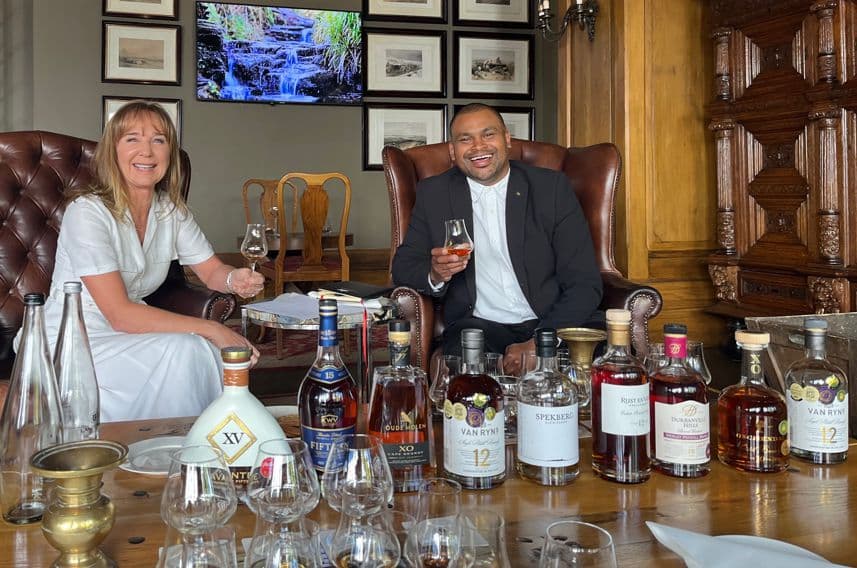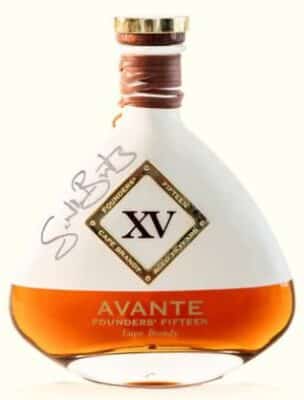Tim James: A fine Cape brandy tasting
By Christian Eedes, 14 April 2025

2
When I wrote about my emptying brandy stocks a month or so back, there were some significant consequences for me, two of them motivated by readers’ comments. Firstly, I was reminded by Gilles that I shouldn’t be too singleminded about the joys of KWV 10 Year Old and, to a lesser degree, 12 Year Old as my “house brandies” – what about the splendid equivalents from Van Ryn’s? I’ve been remedying that, though they’re somewhat pricier, so thanks. And I was prompted by Gareth’s point about brandy’s longevity to think that the promised pleasures of my half-emptied bottle of the sadly discontinued Oude Meester Souverein were not going to stay undiminished forever. I have since taken the plunge and finished the bottle with immense satisfaction. It is still my favourite local brandy ever – a brilliant half-way match between the ripe flavourfulness of most SA brandy and the more savoury refinement of good older cognac. Ah well, I wonder if I’ll ever drink it again.

The third consequence was an invitation from Christelle Reade-Jahn, Director of the SA Brandy Foundation to meet up for a tasting of some top brandies. As her list included some I didn’t know, or hadn’t tried for ages, I was happy to accept. So we met at the lovely Lanzerac hotel in Stellenbosch, with a tasting curated and beautifully presented by an enthusiastic and knowledgeable Shane Mumba, a former sommelier, now itinerant wine consultant, whose work includes acting as a “brand ambassador” for the Foundation.
Shane started us off with the much applauded (internationally and locally) Van Ryn 12 (R640) as a sort of benchmark; its rounded breadth, subtle flavours of fruit and some wood notes, in an elegant but generous whole, served the purpose well. Three more brandies predominantly made from chenin and colombar followed. Oude Molen XO (R1,350) was one of only two in the line-up to use the cognac-style ageing indicator rather than giving its actual average age – in fact the average age is well over the requisite ten years for Cape Brandy (it’s six years for cognac). That ageing, partly in ex-bourbon barrels, ensures its smoothness while it remains fresh. Just a touch more raw than the Van Ryn’s, and a little sweeter on the finish (the addition of sweetening to virtually all brandy – and perhaps even more to cognac – is something the industry doesn’t exactly draw attention to).
Then another famous and internationally awarded brandy from one of the biggest producers: KWV 15 Year Old (R850). In a quite richly ripe style, yet with the refinement that barrel ageing gives. The age also gives some wood-derived notes (spice, tobacco) and an oxidative quality akin to that in tawny port, but fruit (more dried fruit perhaps) is also still obvious, though the complexities of ageing are starting to gain prominence.
 Then there was another 15 year old, recently come to the market and new to me: Avante XV Founders’ Fifteen. It is marketed with a good story (“Led by World Cup winning captain John Smit, this 15-strong squad is selected from international superstars past, present and future”), presumably with a particular appeal to rugby lovers. The brandy comes from the Oude Molen Cellars, but I daresay the “team” had a strong say in its blend, and in the packaging, which is certainly distinctive and maybe some people like it. Unfortunately I didn’t much care for the brandy either. It was by quite a long way the most expensive on this tasting, at around R2,000 (with an extra few hundred bucks to have the bottle signed by one of the “superstars), and it was certainly the one I liked least: big, forward, and fruity-sweet, with a lot of vanilla oak on show; it’s also rather flat and lacking freshness. It got Five Stars in Platter’s last year (but it should be noted that Platters’ is distinctly over-generous in its scores for brandy, something I became regrettably complicit in when I joined one other taster as the Guide’s brandy specialists; scores ratcheted up.) And I believe the initial offering of the Avante XV has done quite well – but let’s see if that success persists.
Then there was another 15 year old, recently come to the market and new to me: Avante XV Founders’ Fifteen. It is marketed with a good story (“Led by World Cup winning captain John Smit, this 15-strong squad is selected from international superstars past, present and future”), presumably with a particular appeal to rugby lovers. The brandy comes from the Oude Molen Cellars, but I daresay the “team” had a strong say in its blend, and in the packaging, which is certainly distinctive and maybe some people like it. Unfortunately I didn’t much care for the brandy either. It was by quite a long way the most expensive on this tasting, at around R2,000 (with an extra few hundred bucks to have the bottle signed by one of the “superstars), and it was certainly the one I liked least: big, forward, and fruity-sweet, with a lot of vanilla oak on show; it’s also rather flat and lacking freshness. It got Five Stars in Platter’s last year (but it should be noted that Platters’ is distinctly over-generous in its scores for brandy, something I became regrettably complicit in when I joined one other taster as the Guide’s brandy specialists; scores ratcheted up.) And I believe the initial offering of the Avante XV has done quite well – but let’s see if that success persists.
Then Boschendal XO (R750), mostly from colombar, and now made in the Sydney Back copper pot at DGB. Its slightly lighter hue presaged a more delicate, lighter, more floral and more elegant style than the ones we’d had so far, though also a touch sweet on the finish. I liked it very much. Another estate example was Durbanville Hills Merlot Potstill Brandy, a ten-year old. This is extremely unusual, not only in being from a black grape but also in having a declared vintage – 2011. The merlot gives it, perhaps, its darker notes of cherry and fruit cake. It also has a drier finish than most, and a touch of herbal bitterness that I rather enjoyed. Somehow a rather sexy brandy in its idiosyncracy, and good value at R440 – I shall buy some, I think.
A second brandy made from black grapes was Rust en Vrede’s 12 Year Old, using the estate’s cabernet sauvignon and old barrels from cab maturation. A totally different proposition from the Durbanville Hills, though – starting with the price of R1,500. It’s big and bold, with plenty of smoky, vanilla wood notes and some tawny port character. For me it was marred by the obvious woodiness and a finish that is particularly sweet.
We finished by returning to pure colombar, with an eight-year-old from perhaps the finest estate brandy producer, Boplaas, but offered as Spekberg. It’s not available commercially, so its presence was a bit irrelevant – except that it was predictably refined and elegant and a good way to finish. Yet another reminder of how bewildering it is that so much not-always-particularly-impressive cognac is sold in South Africa at such high prices when there’s so much fine, older local brandy lingering on the shelves.
- Tim James is one of South Africa’s leading wine commentators, contributing to various local and international wine publications. His book Wines of South Africa – Tradition and Revolution appeared in 2013.







Brendon Shaw | 15 April 2025
The Joseph Barry brandies are great…the Muscat in particular
Stuart Tapson | 23 April 2025
The Tokara brandy is a South African epic